This is a preprint.
Pathogenicity Prediction of GABAA Receptor Missense Variants
- PMID: 38014242
- PMCID: PMC10680766
- DOI: 10.1101/2023.11.14.567135
Pathogenicity Prediction of GABAA Receptor Missense Variants
Abstract
Variants in the genes encoding the subunits of gamma-aminobutyric acid type A (GABAA) receptors are associated with epilepsy. To date, over 1000 clinical variants have been identified in these genes. However, the majority of these variants lack functional studies and their clinical significance is uncertain although accumulating evidence indicates that proteostasis deficiency is the major disease-causing mechanism for GABAA receptor variants. Here, we apply two state-of-the-art modeling tools, namely AlphaMissense, which uses an artificial intelligence-based approach based on AlphaFold structures, and Rhapsody, which integrates sequence evolution and known structure-based data, to predict the pathogenicity of saturating missense variants in genes that encode the major subunits of GABAA receptors in the central nervous system, including GABRA1, GABRB2, GABRB3, and GABRG2. Our results demonstrate that the predicted pathogenicity correlates well between AlphaMissense and Rhapsody although AlphaMissense tends to generate higher pathogenic probability. Furthermore, almost all annotated pathogenic variants in the ClinVar clinical database are successfully identified from the prediction, whereas uncertain variants from ClinVar partially due to the lack of experimental data are differentiated into different pathogenicity groups. The pathogenicity prediction of GABAA receptor missense variants provides a resource to the community as well as guidance for future experimental and clinical investigations.
Keywords: Epilepsy; GABAA receptors; Ion channels; pathogenicity; proteostasis.
Figures
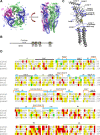
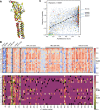
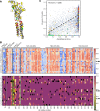
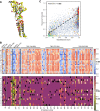
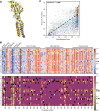
Similar articles
-
Dravet syndrome-associated mutations in GABRA1, GABRB2 and GABRG2 define the genetic landscape of defects of GABAA receptors.Brain Commun. 2021 Mar 11;3(2):fcab033. doi: 10.1093/braincomms/fcab033. eCollection 2021. Brain Commun. 2021. PMID: 34095830 Free PMC article.
-
Evaluating novel in silico tools for accurate pathogenicity classification in epilepsy-associated genetic missense variants.Epilepsia. 2024 Dec;65(12):3655-3663. doi: 10.1111/epi.18155. Epub 2024 Oct 23. Epilepsia. 2024. PMID: 39440667 Free PMC article.
-
Molecular and clinical descriptions of patients with GABAA receptor gene variants (GABRA1, GABRB2, GABRB3, GABRG2): A cohort study, review of literature, and genotype-phenotype correlation.Epilepsia. 2022 Oct;63(10):2519-2533. doi: 10.1111/epi.17336. Epub 2022 Aug 13. Epilepsia. 2022. PMID: 35718920 Free PMC article. Review.
-
Assessing the Utility of ColabFold and AlphaMissense in Determining Missense Variant Pathogenicity for Congenital Myasthenic Syndromes.Biomedicines. 2024 Nov 8;12(11):2549. doi: 10.3390/biomedicines12112549. Biomedicines. 2024. PMID: 39595115 Free PMC article.
-
GABAA Receptor Variants in Epilepsy.In: Czuczwar SJ, editor. Epilepsy [Internet]. Brisbane (AU): Exon Publications; 2022 Apr 2. Chapter 7. In: Czuczwar SJ, editor. Epilepsy [Internet]. Brisbane (AU): Exon Publications; 2022 Apr 2. Chapter 7. PMID: 35605087 Free Books & Documents. Review.
References
-
- Wirrell E. C., Nabbout R., Scheffer I. E., Alsaadi T., Bogacz A., French J. A., Hirsch E., Jain S., Kaneko S., Riney K., Samia P., Snead O. C., Somerville E., Specchio N., Trinka E., Zuberi S. M., Balestrini S., Wiebe S., Cross J. H., Perucca E., Moshé S. L., Tinuper P., Epilepsia 2022, 63, 1333–1348. - PubMed
-
- Perucca P., Bahlo M., Berkovic S. F., Annual review of genomics and human genetics 2020, 21, 205–230. - PubMed
Publication types
Grants and funding
LinkOut - more resources
Full Text Sources
